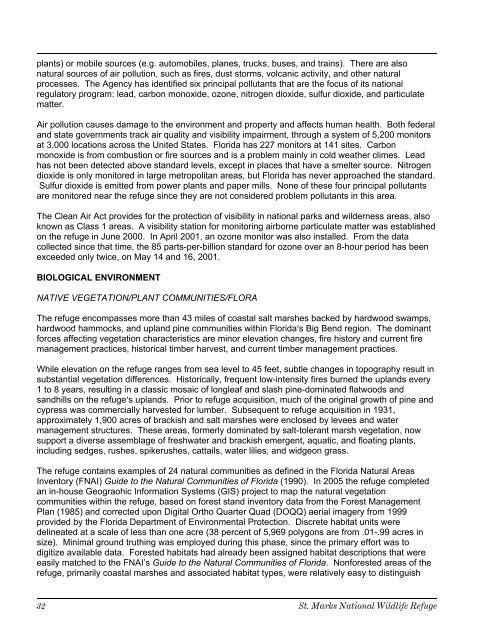St. Marks NWR Comprehensive Conservation Plan - U.S. Fish and ...
St. Marks NWR Comprehensive Conservation Plan - U.S. Fish and ...
St. Marks NWR Comprehensive Conservation Plan - U.S. Fish and ...
Create successful ePaper yourself
Turn your PDF publications into a flip-book with our unique Google optimized e-Paper software.
plants) or mobile sources (e.g. automobiles, planes, trucks, buses, <strong>and</strong> trains). There are also<br />
natural sources of air pollution, such as fires, dust storms, volcanic activity, <strong>and</strong> other natural<br />
processes. The Agency has identified six principal pollutants that are the focus of its national<br />
regulatory program: lead, carbon monoxide, ozone, nitrogen dioxide, sulfur dioxide, <strong>and</strong> particulate<br />
matter.<br />
Air pollution causes damage to the environment <strong>and</strong> property <strong>and</strong> affects human health. Both federal<br />
<strong>and</strong> state governments track air quality <strong>and</strong> visibility impairment, through a system of 5,200 monitors<br />
at 3,000 locations across the United <strong>St</strong>ates. Florida has 227 monitors at 141 sites. Carbon<br />
monoxide is from combustion or fire sources <strong>and</strong> is a problem mainly in cold weather climes. Lead<br />
has not been detected above st<strong>and</strong>ard levels, except in places that have a smelter source. Nitrogen<br />
dioxide is only monitored in large metropolitan areas, but Florida has never approached the st<strong>and</strong>ard.<br />
Sulfur dioxide is emitted from power plants <strong>and</strong> paper mills. None of these four principal pollutants<br />
are monitored near the refuge since they are not considered problem pollutants in this area.<br />
The Clean Air Act provides for the protection of visibility in national parks <strong>and</strong> wilderness areas, also<br />
known as Class 1 areas. A visibility station for monitoring airborne particulate matter was established<br />
on the refuge in June 2000. In April 2001, an ozone monitor was also installed. From the data<br />
collected since that time, the 85 parts-per-billion st<strong>and</strong>ard for ozone over an 8-hour period has been<br />
exceeded only twice, on May 14 <strong>and</strong> 16, 2001.<br />
BIOLOGICAL ENVIRONMENT<br />
NATIVE VEGETATION/PLANT COMMUNITIES/FLORA<br />
The refuge encompasses more than 43 miles of coastal salt marshes backed by hardwood swamps,<br />
hardwood hammocks, <strong>and</strong> upl<strong>and</strong> pine communities within Florida=s Big Bend region. The dominant<br />
forces affecting vegetation characteristics are minor elevation changes, fire history <strong>and</strong> current fire<br />
management practices, historical timber harvest, <strong>and</strong> current timber management practices.<br />
While elevation on the refuge ranges from sea level to 45 feet, subtle changes in topography result in<br />
substantial vegetation differences. Historically, frequent low-intensity fires burned the upl<strong>and</strong>s every<br />
1 to 8 years, resulting in a classic mosaic of longleaf <strong>and</strong> slash pine-dominated flatwoods <strong>and</strong><br />
s<strong>and</strong>hills on the refuge=s upl<strong>and</strong>s. Prior to refuge acquisition, much of the original growth of pine <strong>and</strong><br />
cypress was commercially harvested for lumber. Subsequent to refuge acquisition in 1931,<br />
approximately 1,900 acres of brackish <strong>and</strong> salt marshes were enclosed by levees <strong>and</strong> water<br />
management structures. These areas, formerly dominated by salt-tolerant marsh vegetation, now<br />
support a diverse assemblage of freshwater <strong>and</strong> brackish emergent, aquatic, <strong>and</strong> floating plants,<br />
including sedges, rushes, spikerushes, cattails, water lilies, <strong>and</strong> widgeon grass.<br />
The refuge contains examples of 24 natural communities as defined in the Florida Natural Areas<br />
Inventory (FNAI) Guide to the Natural Communities of Florida (1990). In 2005 the refuge completed<br />
an in-house Geograohic Information Systems (GIS) project to map the natural vegetation<br />
communities within the refuge, based on forest st<strong>and</strong> inventory data from the Forest Management<br />
<strong>Plan</strong> (1985) <strong>and</strong> corrected upon Digital Ortho Quarter Quad (DOQQ) aerial imagery from 1999<br />
provided by the Florida Department of Environmental Protection. Discrete habitat units were<br />
delineated at a scale of less than one acre (38 percent of 5,969 polygons are from .01-.99 acres in<br />
size). Minimal ground truthing was employed during this phase, since the primary effort was to<br />
digitize available data. Forested habitats had already been assigned habitat descriptions that were<br />
easily matched to the FNAI’s Guide to the Natural Communities of Florida. Nonforested areas of the<br />
refuge, primarily coastal marshes <strong>and</strong> associated habitat types, were relatively easy to distinguish<br />
32<br />
<strong>St</strong>. <strong>Marks</strong> National Wildlife Refuge

















